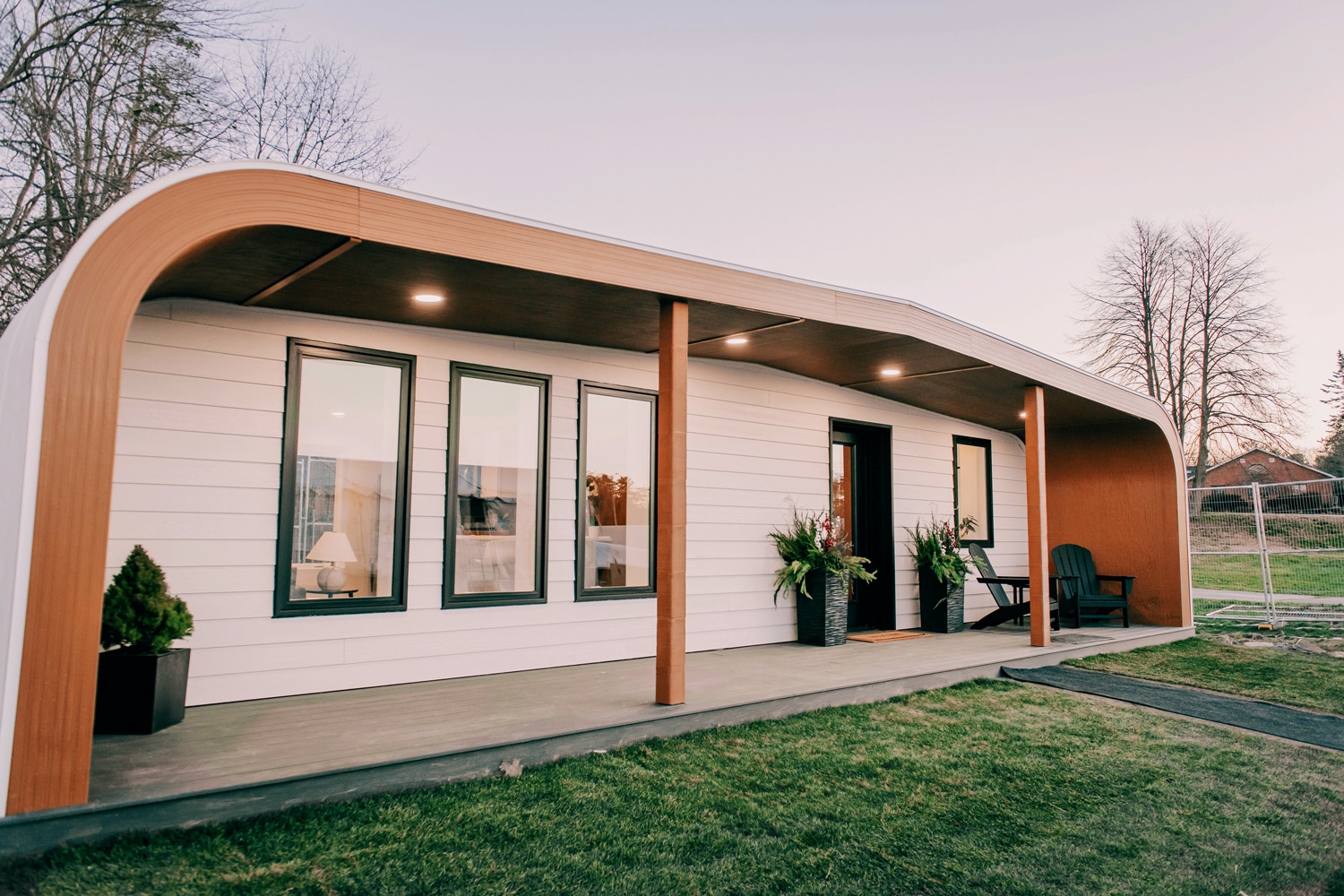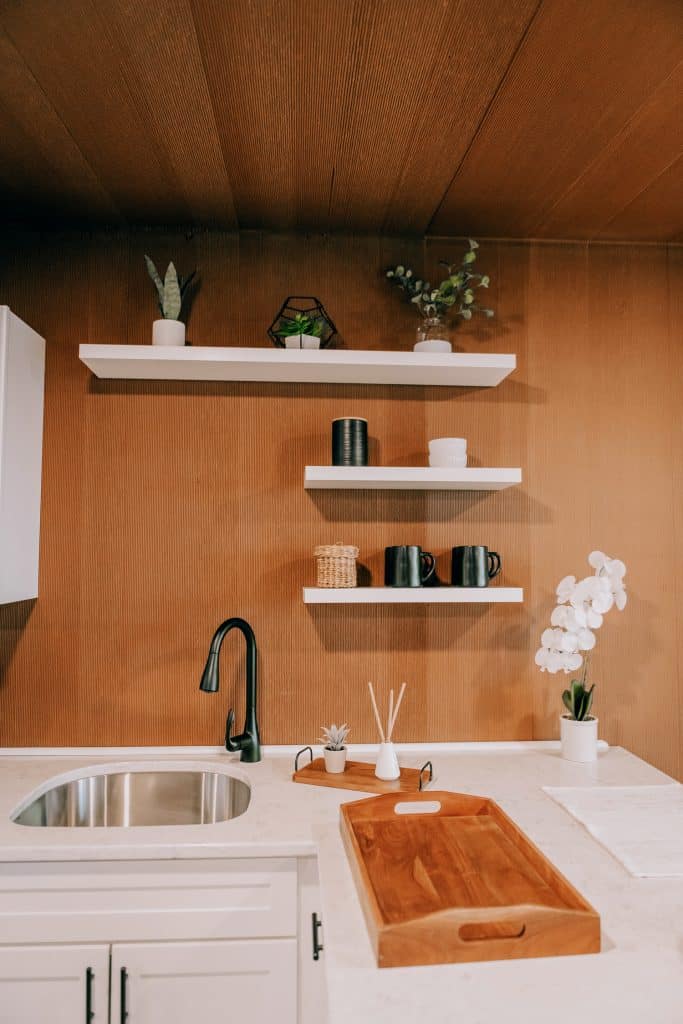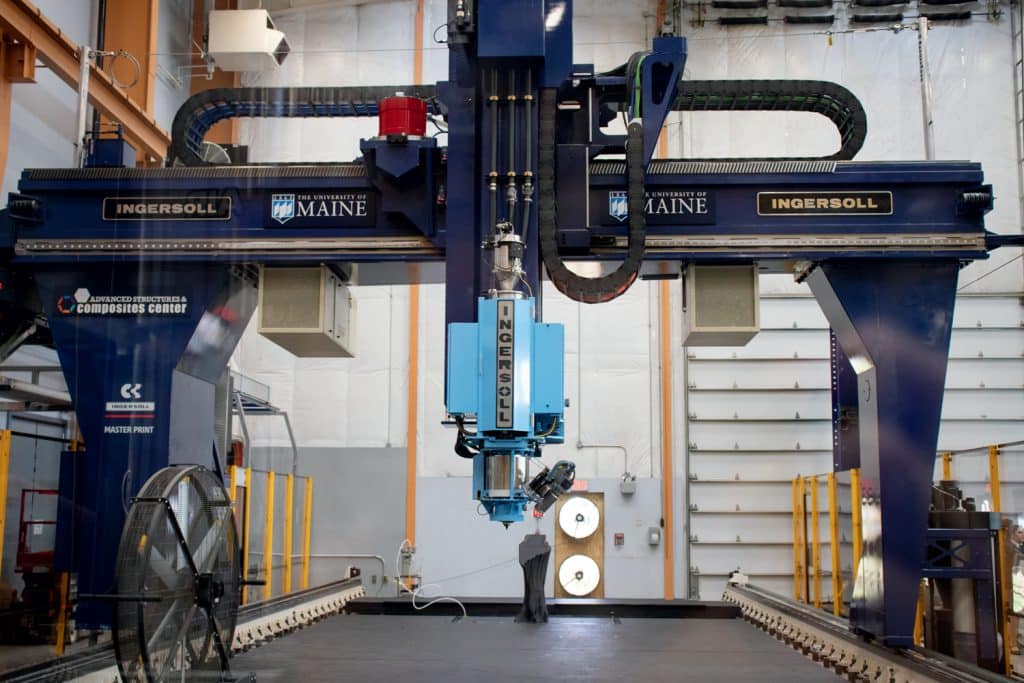The University of Maine’s House with 3D Vision
An experimental home created by UMaine engineers offers hope for the affordable-housing crisis and for the future of Maine’s timber industry.

Coffee By Design | Portland, Maine
Photo Credit : Katherine KeenanBeyond a vast parking lot brimming with cars, and a field filled with last summer’s goldenrod, the printed house huddles by itself—a one-story structure with a roof that curves like shoulders.
Diminutive compared with the magisterial buildings spread across the University of Maine in Orono—a rare campus designed by Frederick Law Olmsted—this structure, a cross between a cottage and a Quonset hut, wasn’t built in a conventional way. That is to say, over the course of months, using lumber and nails, sawed and hammered by people wearing tool belts and clinging to ladders. It was three-dimensionally printed by a futuristic-looking machine using “bio-based” materials—namely, 10 tons of sawdust.
Last March, as a cold rain fell, I ducked inside. The foyer was warm, cozy—an immediate reprieve. I noticed its walls, which aren’t smooth, but textured like horizontal corduroy and feel ever-so-slightly cat’s-tongue rough to the touch. Another novelty are the corners: Instead of meeting at crisp right angles, its walls arc into the ceiling.
Otherwise, the one-bedroom, one-bathroom house has a familiar layout and is furnished as if it already belongs to someone with a yen for neutral hues. A beige blanket drapes across a queen bed with matching pillows. An ivory-colored wool rug spreads across the floor. There’s a little desk nook with an open laptop near a window. In the bathroom, a white porcelain sink and tub gleam. A tray of mugs basks on the kitchen counter, and a gray crock of cooking utensils stands by the stove. Natural light pours through several tall windows at the front and back of the house. Across from the kitchen area, a manila-colored couch and two matching chairs cluster by a coffee table. Above, a wide-screen TV plays a video loop of the house’s fabrication.

Photo Credit : MJ Gauntrau/University of Maine

Photo Credit : MJ Gauntrau/University of Maine
In the sped-up time-lapse video, an enormous robotic “pen” is in frantic constant motion, pivoting-shifting-swerving, as its “nib” deposits contiguous beads of “ink.” The ink? Sawdust. As the pen moves, the house magically emerges, a gingerbread-colored wall rising from the laboratory floor. There are seemingly no people on the premises, but if you scan the footage carefully: A phantomlike man wearing a blue hard hat and safety jacket pops in sporadically to inspect “the print,” as the house materializes.
This 600-square-foot abode—which has hunkered behind UMaine’s Advanced Structures and Composites Center (ASCC) since its installation in November 2022—has stood strong and snug through a range of Maine’s weathers. Amid heavy snowstorms, a minus-30-degree polar vortex, winds of over 50 mph, and a wave of steamy summer days, it’s maintained a constant temperature of 60 to 70 degrees, courtesy of its deep insulation and two heat pumps.
The world’s first bio-based 3D-printed house—the brainchild of two men who grew up on opposite sides of the world—was created to address two seemingly unrelated yet equally urgent issues: Maine’s dearth of affordable housing and its crumbling timber industry. But as I found out, the story of this house cannot be told without knowing how and why it is here, and why Maine’s infinite forest is at the heart of an ingenious plan to reimagine life for thousands of the state’s residents.
• • • •
A few miles east of the printed house is the Maine Forest and Logging Museum. Situated at the end of a dirt road within the university’s experimental forest, it’s a quiet spot: “Six people [a day] is as busy as it gets,” says the museum’s seasonal caretaker, Kevin Gericke. But to those who poke their heads into the main office asking for a map, Gericke recommends touring the reproduction of a 1700s-era sawmill. Down the trail, across the covered bridge, there it is: a timber-frame structure smelling like fresh-milled lumber. Made entirely from trees, it’s a building whose function is to mill yet more trees, to construct more buildings. And inside, at the point where freshly cut boards spill away from the saw blade, stand two barrels ready to collect the humble residue: sawdust.
Two centuries ago, when Maine separated from Massachusetts and became its own state in 1820, vast northern timberlands were suddenly up for grabs, drawing investors and fortune hunters. Lumberjacks felled white pine, hemlock, spruce, fir, and beech from Maine forests, furnishing logs that were floated down the Penobscot River to Bangor. By 1830, there were 300 sawmills surrounding Bangor, and soon the city’s fame as a wood producer spread around the world. In the 20th century, paper mills fed by wood pulp became Maine’s biggest employers. But time has not been kind. Today the timber industry is faltering, and most of the state’s mills have shuttered—all while the average price for the state’s limited housing stock has been driven up by out-of-staters who relocated to Maine during the pandemic.
• • • •
In downtown Bangor, beyond an entrance sign reading “Helping Today, Building Tomorrow,” two receptionists at Penquis are fielding endless requests for housing assistance. A nonprofit organization whose focus is eliminating poverty, Penquis oversees 50 different social services, of which 20 percent are directly tied to housing issues. “Home Is Key” reads a pamphlet in the waiting area. While I am there, a man in his 50s tells a receptionist he’s been living in his car, but now it’s been impounded. A woman carrying a toddler on each hip explains, “I need a place to stay.” A lady in her 80s is looking for help because she’s been evicted; new owners purchased the apartment complex where she’s lived for decades, and they’ve raised the rent far beyond what she can afford on her fixed income.

Photo Credit : University of Maine
Later, with snow on the ground and temperatures in the upper 20s, I drive around Bangor with Penquis’s housing development director, Jason Bird. He points out a modest two-story with a “For Sale” sign. “They’re asking $185,000,” he says. “Probably two years ago, that would have been less than $100,000.” According to a 2022 report by the Joint Center for Housing Studies at Harvard, the income needed to buy a median-priced home in Bangor is $66,164. But according to U.S. census data from the same year, per-capita income in the city is just over $36,000.
Less than a mile away, we pass one of several sprawling encampments that in recent years have hosted as many as 70 people. There are multiple tents and garbage bags and plastic coolers and other items clustered across the snowy field. “For years we’ve known about the housing crisis,” Bird tells me, “but now, everyone else sees it.” And after my tour with Bird, while leaving my downtown Bangor Airbnb I realize three people have spent the night sleeping across the street, by the front steps of the Penobscot County Federal Credit Union.
Yet as Heidi LeBlanc, Penquis’s chief operating officer, notes: There are small wins in this crisis. Over the past six months, Penquis has housed 20 families, helped five people avoid eviction, and gotten three individuals into temporary housing. An influx of new affordable and efficient small homes could change the lives of families they see every day.
• • • •
Mark Wiesendanger’s family has been involved in Maine’s lumber industry for more than a century. However, for the past eight years, he has worked as the development director for MaineHousing, a 50-plus-year-old state agency that functions like a $2 billion bank to help people buy, rent, repair, and heat their homes. In 2019, Wiesendanger was walking in a parade alongside a float conveying the world’s largest solid 3D-printed object, a boat created at UMaine’s Advanced Structures and Composites Center, when he had an idea. In November 2019, he put that idea into an email to Habib Dagher, the ASCC’s founding executive director and a professor of structural engineering at UMaine.

Photo Credit : University of Maine

Photo Credit : University of Maine
Wiesendanger explained how his agency funds nearly all of the affordable housing created in Maine, which at the time needed at least 20,000 affordable units. But given the dramatic rise in construction costs, coupled with the labor shortage—demographically, Maine is the nation’s “oldest” state—MaineHousing was able to realize only 200 to 300 housing units per year, Wiesendanger wrote. At that rate, the state’s demand for affordable housing wouldn’t be met for a century.
An obvious way to tackle the problem would be to expand the construction labor force, but Wiesendanger thought advances like 3D printers might soon make those positions obsolete. Maybe, he proposed, this was an opportunity “to create a new type of housing … using new Maine-based wood-based technologies that would be durable and energy-efficient, and would benefit the local economy.” Furthermore, what if there were a way to reduce transportation costs for materials and labor? And what if the solution could showcase Maine innovation while also fulfilling a public need?
Dagher was intrigued. Born in Guinea and raised in Beirut—where he turned his bedroom into a chemistry lab—he had earned three advanced degrees in civil and structural engineering before arriving at UMaine in the mid-1980s. Not long after, he was walking along Portland’s seaport when he noticed heaps of hemlock trunks. “I guess they’re going overseas for somebody to make a product and sell it back to us,” a dockworker told him.
This led Dagher to apply for, and receive, the first of hundreds of grants to build a laboratory on campus where, among other initiatives, he and his team could develop new products, including wood composites, that utilized Maine’s timber. In 2008, for instance, they used raw materials from Maine forests to produce a blast-and-fragment-resistant tent for the U.S. Army Corps of Engineers. Subsequently, the ASCC’s engineers began innovating with the world’s largest 3D printer, earning Guinness Book World Record honors in 2019 for fabricating the world’s largest solid 3D-printed object, the same boat that Wiesendanger had seen. That same year they printed a 90-square-foot military communications shelter that was designed to fit on the back of a truck.

Photo Credit : Courtesy of MaineHousing
One morning in late 2019, having mulled over Wiesendanger’s email, Dagher turned to ASCC engineer Scott Thomlinson and asked, “Can you print a house in the next two weeks?” Thomlinson, a large-framed man who bides his time before speaking, considered the matter. “Maybe,” he said.
The world’s first bio-based 3D-printed home was executed the same way a student might cram for an exam or churn out a term paper: in a series of hyperfocused, largely sleepless, pizza-fueled episodes. By early November 2022, three years after Wiesendanger’s initial email, Dagher and his team were weeks away from debuting their first-of-its-kind-never-been-tried-before project, laboring inside the ASCC’s hangar-like laboratory at the campus’s east end.
Over the previous months, Dagher and his team’s attempts to address Maine’s housing crisis using inexpensive, abundant materials to manufacture a ready-to-inhabit home had been immersed in intense, confidential development. In the lead-up to the prototype’s unveiling, however, most of what they had to show for their efforts was a conference table’s worth of miniature one-story bungalows.
“Fail fast and cheap” is one of Dagher’s maxims, which explained the dozens of toy-size printed models, each representing an idea the team had tested on its way to designing a home that was recyclable but also fire retardant and handicap accessible and met all the building codes. These “failures” also helped answer key questions, such as whether the house should be printed as a single object or as a series of modules. And if the former were actually doable, how might they transport it to the building site? Or, if the latter was desirable, could they fit the modules together with no gaps at the joints?
Another of Dagher’s slogans, posted in the meeting room next to the 100,000-square-foot lab, reads: “None of us is as smart as all of us.” Dagher is quick to credit his team for its holy-cow inventions, like the “bridge in a backpack” (actually a hockey bag) that contains all the materials necessary to construct a durable, noncorrosive, vehicle-bearing bridge, and that world-record-winning boat, “3Dirigo,” whose name was inspired by the state motto, translated as “I lead.” To date, the ASCC has registered 120 patents, created 14 spin-off companies, and won 40 awards for research excellence.
With deadline looming, Dagher and his team readied the four modules of the house that they’d printed individually using sawdust milled further into flour and combined with a corn-based binder. It can be confusing, they know, to conceive of “printing” a house. Visitors to the lab frequently express something along the lines of “How does a printer that spits out pages with words equate to a printer that can spit out a house?” Team members explain, “Think of it like a giant pastry bag that’s piping out icing.”
Days before the November 21 unveiling, each of the modules— the living room/kitchen, the bedroom, the bath/foyer, and the porch—was hauled from the lab on the back of a flatbed truck and driven to the building site behind the laboratory, overlooking an open field backed by a four-acre parking lot. There, a crane moved each module into place, and electricians hooked up the lights and heat pumps. Assembly took half a day. By nightfall on November 20, the once-empty patch behind the lab now hosted a printed house. Had you crossed the campus at dusk, you would have seen lights where they had never been, glowing from the windows of the university’s newest structure.
• • • •
On an aggressively hot September day in 2023, six months after my first visit, I tagged along on a tour of the printed house. Crossing its threshold, I relished the home’s 65-degree coolness. The tour guide explained how before printing the house, Dagher and his team had tortured the building materials in their lab, subjecting them to prolonged extremes of heat, cold, dryness, and moisture. Embedded sensors in the finished house now collect data about temperature, moisture, and UV effects, part of an ongoing study of how the structure responds to Maine’s climate.
“It’s spacious,” observed one of the tour participants, Thom Rawson, associate professor at Japan’s Nagasaki International University. But prowling the bedroom, he noted, “There’s not much closet space.” Rawson continued his appraisal as if the place was for sale. Given that he’s 6 foot 8 “with a slouch,” his head skimmed the doorway. “Could they raise the ceiling?” he wondered. “I don’t want to be bonking my head all the time.” And the roof: “How does it handle the snow load?”
The team worked closely with a Portland architectural firm to ensure the house met all building codes. To the disappointment of curious visitors, however, insurance laws prohibit overnight guests. Presently, the house has no running water. And while the engineers intended the house to be powered by solar electricity, university officials nixed that idea. So for those in the market to purchase, the ASCC’s communications team explains that although the university owns the intellectual property to this prototype, “we are never going to be a [private] housing company.”
The sign out front proclaims the printed house’s true intention: “A bold solution to address the nation’s affordable-housing crisis.”
• • • •
Between the front porch of the printed house and the vast commuter-student parking lot, there’s a few football fields’ worth of open space. This cricket-and-goldenrod-filled swath of land will be the home of UMaine’s Factory of the Future, slated to break ground this summer. Here, Dagher’s team will scale up production. The facility’s layout will resemble a “next-generation car-manufacturing line,” Dagher says, and its homes will be built in modules by students trained to operate a building-sized printer.
As Wiesendanger noted in his initial email to Dagher, the printed house can do more than address an affordable-housing problem—it can also address an industry problem. There are millions of tons of wood residuals in the Bangor region alone. The first printed house used 10 tons of it; by Dagher’s estimates, there’s enough nearby for the new factory to produce 100,000 more. It’s a potential supply-and-demand game changer not only in Maine, but also throughout New England and beyond.
The factory’s automated technology will allow for the production of multiple houses in a month’s time, versus the many months it takes to produce one conventionally built home. Through a partnership with MaineHousing and Penquis, nine of those printed homes are already spoken for and will be delivered to a site in Bangor to become the world’s first neighborhood of affordable bio-based printed homes.
Sometimes skeptical of technology’s promises, I reflect on my visit to the Maine Forest and Logging Museum’s visitor center, where a black-and-white video plays on a loop in a side room. In the video, a vehicle resembling a train engine chugs through the snow, pulling a series of sleds brimming with Maine timber. This is the Lombard steam log hauler, invented at the turn of the 20th century by Maine’s own Alvin Lombard. Nicknamed “Mary Anne,” it traveled 5 mph, had no brakes, and took four people to operate. It replaced the work of 50 horses.
Other than a glimpse of a man jabbing a log with a peavey, a type of lumberjack tool, there are no people in the video. Instead it features panning shots of the iron behemoth blasting across the wood’s edge, spewing smoke and steam, towing part of the forest. Two of these obsolete machines hunker in the visitor center’s back room, where one can gawk at the most enduring aspect of Lombard’s invention. In 1900 he patented the log hauler’s continuous track tread, which became the prototype for all the tracked vehicles that followed—from the Sherman tank to the moon rover.
“I’m so glad they thought to document this,” museum caretaker Kevin Gericke said of the nine-minute video. “I mean, at the time this was cutting-edge!”
It strikes me that technology is an elastic word that can be applied to all manner of tools. The peavey is technology; Mary Anne is technology. Then I think about the time-lapse documentary video playing in the printed house on an endless loop, and I try to fathom how one day it, too, may become an antique sideshow.
Wiesendanger, who first lobbed his idea into Dagher’s lab just four years ago, looks forward to the day when the Factory of the Future can 3D-print multifamily homes with units that stack upward like Legos, because stand-alone houses aren’t ideal for cities. Yet even with ongoing improvements—the lab’s updated extruder head now prints 500 pounds per hour, compared with its original 150 per hour—questions remain. For instance, can the factory achieve a scale and level of efficiency great enough to drive the cost down?
A solution to endemic housing shortage isn’t going to happen overnight, Dagher concedes. But in the field where goldenrod ripples and crickets tick off the minutes till winter, an infinity of crumbs from Maine’s old forest industry—sawdust—may soon give rise to a new one.







